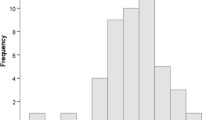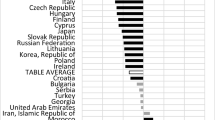ABSTRACT
Typically, mathematics and science are seen as linked together, where both subjects involve numbers, critical thinking, and problem solving. Our study aims to develop a better understanding of the connections between student’s achievement scores in mathematics and science, student gender, and self-efficacy. We used the Trends in International Mathematics and Science Study 2007 eighth grade data to answer our research questions and were able to demonstrate that when controlling for self-efficacy, there is a statistically significant difference in the achievement scores between males and females by subject, where females score higher Algebra, but males score higher in the other mathematics subjects. Likewise, we were also able to demonstrate that there is a statistically significant difference in the achievement scores in Earth Science, Physics, and Biology, between males and females where males score higher in science subjects. In both mathematics and science examinations, we controlled for self-efficacy where in mathematics females hold lower self-efficacy then males and in science there is no difference between females and males in terms of self-efficacy. We conjecture that mathematics and science classrooms that consider self-efficacy may impact student’s achievement scores by subject, which can ultimately impact career choices in mathematics- and science-based fields.
Similar content being viewed by others
References
Anyon, J. (1980). Social class and the hidden curriculum of work. Journal of Education, 162(1), 67–92.
Baker, F. B. (2001). The basics of item response theory. ERIC Clearinghouse on Assessment and evaluation (2nd ed). Retrieved from http://info.worldbank.org/etools/docs/library/117765/Item%20Response%20Theory%20-%20 F%20Baker.pdf
Bandura, A. (1986). Social foundations of thought and action: A social cognitive theory. Englewood Cliffs, NJ: Prentice Hall.
Bandura, A. (1994). Self-efficacy. In V. S. Ramachandran (Ed.), Encyclopedia of human behavior (Vol. 4, pp. 71–81). New York: Academic Press.
Bandura, A., Barbaranelli, C., Caprara, G. V. & Pastorelli, C. (2001). Self-efficacy beliefs as shapers of children’s aspirations and career trajectories. Child Development, 72(1), 187–206.
Beaton, A., Tougas, F., Rinfret, N., Huard, N. & Delisle, M. N. (2007). Strength in numbers? Women and mathematics. European Journal of Psychology of Education, 22(3), 291–306.
Beller, M. & Gafini, N. (1996). The 1991 international assessment of educational progress in mathematics and science: The gender differences perspective. Journal of Educational Psychology, 88, 365–377. doi:10.1037/0022-0663.88.2.365.
Britner, S. I. & Pajares, F. (2006). Sources of science self-efficacy beliefs of middle school students. Journal of Research in Science Teaching, 43(5), 485–499. doi:10.1002/tea.20131.
Brown, A. S., & Brown, L. L. (2007). What are science & math test scores really telling U.S.? The Bent of Tau Beta Pi, Winter, 13–1. Retrieved from http://www.tbp.org/pages/publications/Bent/Features/W07Brown.pdf
Brush, L. R. (1985). Cognitive and affective determinants of course preferences and plans. In S. F. Chipman, L. R. Brush & D. M. Wilson (Eds.), Women and mathematics balancing the equation (pp. 123–150). Hillsdale, NJ: Erlbaum.
Chen, P. & Zimmerman, B. (2007). A cross-national comparison study on the accuracy of self-efficacy beliefs of middle-school mathematics students. The Journal of Experimental Education, 75(3), 221–244.
Chiu, M. M. (2009). Inequalities' harmful effects on both disadvantaged and privileged students: Sources, mechanisms, and strategies. Journal of Educational Research, 3(1/2), 109–127.
Foy, P. & Olson, J. F. (2009). TIMSS 2007 international database and user guide. Chestnut Hill, MA: TIMSS & PIRLS International Study Center, Boston College.
Frenzel, A. C., Pekrun, R. & Goetz, T. (2007). Girls and mathematics—a hopeless issue? A control-value approach to gender differences in emotions towards mathematics. European Journal of Psychology of Education, 22(4), 497–514.
Greenwood, J. (1984). Soundoff: My anxieties about math anxiety. Mathematics Teacher, 77(9), 662–663.
Grusec, J. E. (1992). Social learning theory and developmental psychology: The legacies of Robert Sears and Albert Bandura. Developmental Psychology, 28(5), 776–786. doi:10.1037/0012-1649.28.5.776.
Holliday, W. G. & Holliday, B. W. (2003). Why using international comparative math and science achievement data from TIMSS is not helpful. The Educational Forum, 67(3), 250–257.
Hyde, J. S., Fennema, E., Ryan, M., Fros, L. A. & Hopp, C. (1990). Gender comparisons of mathematics attitudes and affect. Psychology of Women Quarterly, 14(3), 299–324.
Hyde, J. S. & Mertz, J. E. (2009). Gender, culture, and mathematics performance. Proceedings of the National Academy of Sciences of the United States of America, 106(22), 8801–8807. doi:10.1073/pnas.0901265106.
Katz, S., Allbritton, D., Aronis, J., Wilson, C. & Soffia, M. L. (2006). Gender, achievement and persistence in an undergraduate computer science program. The Database for Advances in Information Systems, 37(4), 42–57.
Keith, T. Z. (2006). Multiple regression and beyond. Boston, MA: Pearson.
Ma, X. (1999). A meta-analysis of the relationship between anxiety toward mathematics and achievement in mathematics. Journal for Research in Mathematics Education, 30(5), 520–540.
Ma, X. & Cartwright, F. (2003). A longitudinal analysis of gender difference in affective outcomes in mathematics during middle and high school. School Effectiveness and School Improvement, 14(4), 413–439.
Merrill, C. & Daugherty, J. (2010). Stem education and leadership: A mathematics and science partnership approach. Journal of Teaching Education, 21(2), 21–34.
Olson, J. F., Martin, M. O. & Mullis, I. V. S. (2008). TIMSS 2007 technical report. Chestnut Hill, MA: TIMSS & PIRLS International Study Center, Boston College.
Pajares, F., Britner, S. & Valiante, G. (2000). Relation between achievement goals and self-beliefs of middle school students in writing and science. Contemporary Educational Psychology, 25(4), 406–422. doi:10.1006/ceps.1999.1027.
Pajares, F. & Valiante, G. (1999). Grade level and gender differences in the writing self-beliefs of middle school students. Contemporary Educational Psychology, 24(4), 390–405.
Rutherford, F. J. (1997). Thinking quantitatively about science. In L. A. Steen (Ed.), Why numbers count (pp. 60–74). New York: The College Entrance Board.
Satake, E. & Amato, P. P. (1995). Mathematics anxiety and achievement among Japanese elementary school students. Educational and Psychological Measurement, 55(6), 1000–1007. doi:10.1177/0013164495055006009.
Skaalvik, E. M. & Skaalvik, S. (2006). Self-concept and self-efficacy in mathematics: Relation with mathematics motivation and achievement. Proceedings from ICLS ’06 International Conference on Learning Sciences.
Stuart, V. (2000). Math curse or math anxiety? Teaching Children Mathematics, 6(5), 330–335.
Taasoobshirazi, G. & Carr, M. (2008). Gender differences in science: An expertise perspective. Education Psychology Review, 20(2), 149–169.
The President’s Council of Advisors on Science and Technology (2011). K–12 science, technology, engineering, and math (STEM) education for America’s future. Tech Directions, 70(6), 33–34.
Usher, E. (2009). Sources of middle school students’ self-efficacy in mathematics: A qualitative investigation. American Educational Research Journal, 46(1), 275–314.
Usher, E. & Pajares, F. (2009). Sources of self-efficacy in mathematics: A validation study. Contemporary Educational Psychology, 34, 89–101.
Wang, J. (2001). TIMSS primary and middle school data: Some technical concerns. Educational Researcher, 30(6), 17–21. doi:10.3102/0013189X030006017.
Wilkins, J. L. M. (2004). Mathematics and science self-concept: An international investigation. The Journal of Experimental Education, 72(4), 331–346.
Zakaria, E. & Nordin, M. N. (2008). The effects of mathematics anxiety on matriculation students as related to motivation and achievement. Eurasia Journal of Mathematics, Science & Technology Education, 4(1), 27–30.
Zeldin, A. L., Britner, S. L. & Pajares, F. (2008). A comparative study of the self-efficacy beliefs of successful men and women in mathematics, science, and technology careers. Journal of Research in Science Teaching, 45(9), 1036–1058. doi:10.1002/tea.20195.
Author information
Authors and Affiliations
Corresponding author
Appendices
Appendix 1
Grade 8 Student Questionnaire
The Likert-type scale:
-
1: Agree a lot 2: Agree a little 3: Disagree a little 4: Disagree a lot
-
9.
How much do you agree with these statements about learning mathematics?
-
(a)
I usually do well in mathematics
-
(b)
I would like to take more mathematics in school
-
(c)
Mathematics is more difficult for me than for many of my classmates
-
(d)
I enjoy learning mathematics
-
(e)
Mathematics is not one of my strengths
-
(f)
I learn things quickly in mathematics
-
(g)
Mathematics is boring
-
(h)
I like mathematics
-
(a)
-
12.
How much do you agree with these statements about learning science?
-
(a)
I usually do well in science
-
(b)
I would like to take more science in school
-
(c)
Science is more difficult for me than for many of my classmates
-
(d)
I enjoy learning science
-
(e)
Science is not one of my strengths
-
(f)
I learn things quickly in science
-
(g)
Science is boring
-
(h)
I like science
-
(a)
Appendix 2: SPSS Output
Self-Efficacy Construct Reliability
ANOVA for Gender and Self-Efficacy in Math
ANOVA for Gender and Self-Efficacy in Science
ANOVA for Gender and Scores in Math
ANOVA for Gender and Scores in Science
MANCOVA for Gender and Subject with Self-Efficacy in Math
MANCOVA for Gender and Subject with Self-Efficacy in Math
Rights and permissions
About this article
Cite this article
Louis, R.A., Mistele, J.M. THE DIFFERENCES IN SCORES AND SELF-EFFICACY BY STUDENT GENDER IN MATHEMATICS AND SCIENCE. Int J of Sci and Math Educ 10, 1163–1190 (2012). https://doi.org/10.1007/s10763-011-9325-9
Received:
Accepted:
Published:
Issue Date:
DOI: https://doi.org/10.1007/s10763-011-9325-9




